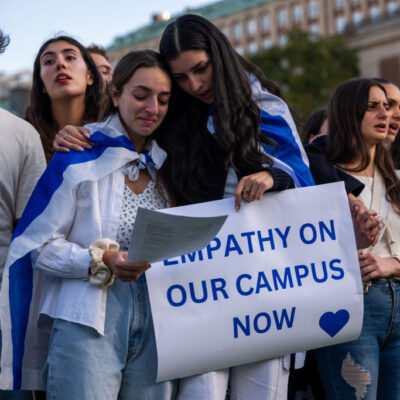Scrapping Synagogue Dues: A Case Study
Scrapping Synagogue Dues: A case study of one synagogue that radically altered their dues system and found more money, more members and more harmony
by Dan Judson
The synagogue dues structure has recently become the source of a lot of conversation – on web forums, at Federation events and at synagogue conventions, people are questioning the long-term sustainability of the membership dues structure. As a result of the recession and longer term demographic trends, many synagogues are facing fewer members as well as members who are hoping to pay less. In 2008, one large conservative synagogue in suburban Boston, Temple Israel of Sharon, was facing a significant problem of declining revenue from dues. “Each year we were raising dues to make our budget numbers, and we reached a point where we were actually losing money when we raised dues. We were on the wrong side of the demand curve,” said Rob Carver, a lay leader at Temple Israel and a professor of statistics, “we had reached a price point where families decided they would rather not belong to the synagogue at all, than pay higher dues. Of course families could come to us for an abatement, but everyone finds the abatement process onerous, so some families just leave. And raising dues again, particularly at the height of the recession, just seemed to sow ill will amongst the congregation.” As a result of this situation, the congregation began a search to replace their dues structure.
At first they investigated “fair share” dues, whereby synagogues peg the amount of dues to the adjusted gross income of the family – usually synagogues ask between 1% and 1.5%. But this turned out to be a non-starter in the congregation, as members did not feel comfortable with this approach. So the synagogue was in a bind – it wanted to change the dues structure, but folks were not willing to utilize a fair share system. So Temple Israel did something somewhat radical: they scrapped the dues system altogether. They went to an entirely voluntary system where families simply told the synagogue how much they were going to pay that year. No fixed dues.
Rob Carver put it this way, “Of course some folks were very worried that this was not going to work. How could a voluntary system work, particularly at the height of the recession? People will simply pledge a low number and we will not raise our revenue. So we developed what we call a sustaining amount. This is the amount that each family would need to pay in order for us to meet our budget. At the membership renewal time, we send a letter saying this is the sustaining amount we need – if you can do this great, if you can go above this, even better – but you tell us how much you are going to pay, and that’s what you will pay.”
The synagogue adopted the revised system three years ago in 2008, and the first two years saw revenues decline, but at a lower rate (4%) than they had declined the previous year under the old system, and this past year, the downward trend has reversed itself and revenue was up 2% from the previous year. The fact that the synagogue made this change at the height of the recession and the still lingering bad economy makes the upward revenue shift all the more remarkable. More significantly, perhaps, than the revenue change was the membership change.
This year, the synagogue saw a net increase of over twenty new families into the congregation, reversing a long trend of downward numbers. The synagogue’s financial team noted, “The new commitment structure has completely transformed the conversation about why members choose to affiliate with the Temple or not. Because the commitment amount is presented as a personal financial decision that is not questioned by the Temple administrative or finance staff, it is no longer a hurdle to affiliation.” Temple Israel’s leadership doesn’t presume that the membership increase is solely due to the new dues structure, but it is undoubtedly a primary factor in this economically sensitive environment. “We continue to fight the demographic challenges in our own town and, of course, the new dues structure isn’t a panacea. Yet we have seen several members who had chosen to disaffiliate in the last few years decide to return this year.”
Debbie Astor, the Executive Director of Temple Israel, added that the change in financing structure has created, “a whole new world of better feelings around money in the synagogue. It has changed the story of what a synagogue expects. It isn’t a board of directors that no one knows, determining that dues are going up x%, it is a completely positive decision each household makes. They are making a choice that can vary from year to year based on personal circumstances. And I have noticed an almost complete absence of any resentment, anger or feeling under the gun.”
One of the beneficial consequences of the new system is that the synagogue no longer has to chase people down who have not fulfilled their pledges. “Because of the voluntary nature of the system,” Astor said, “there is just a miniscule number of people who do not fulfill their financial commitment. It is very different from the way things used to be.” In one fell swoop the synagogue got rid of the time they spent trying to get dues paid, and perhaps even more importantly, they got rid of the abatement system. The old abatement system at Temple Israel, like most synagogues, was intended to help people, but inevitably led to rancor. “People were coming to meetings very defensively and congregants who were on the dues abatement committee did not like having to be the arbiter of people’s financial situation,” said Astor.
Other benefits to the synagogue as a result of the new structure can be seen in yearly write-offs and cash flow. Because congregants almost universally give their pledge amount, and do it on a regular basis, the synagogue only has to write off a few thousand dollars each year as uncollectable, a much smaller number than what was previously written off, which allows for better budget projections. Congregants also pay on a more regular basis so the cash flow for the synagogue is improved, obviating the need to borrow at the end of the year to make up for any shortages.
One of the surprising discoveries of the dues change was the number of people who ended up giving more to the synagogue than they had under the old system. Specifically, the synagogue was surprised to see that a number of families who under the old system had gone through abatement and were asked to pay a minimum amount of $500, under the new voluntary system are committing to a higher amount. Ironically, the synagogue was being more generous than it needed to be under the old system.
The synagogue was also surprised by the number of people who are giving over the sustaining amount. One of the worries of moving to a fair share system is that congregants at the higher end of a fair share system tend to have inflated costs for synagogue membership. If they are not heavy users of the synagogue, there is some incentive for them to leave if they feel overburdened and join another synagogue to pay more typical fees. Temple Israel has had no one at the high end of the financial spectrum leave, and has seen just the opposite. High end users as a group have increased the total amount they have given to the synagogue each of the past three years.
Another effect of the change is on donor recognition. The synagogue publishes a list for those families who give more than the sustaining number. But the synagogue also recognizes anyone who gives more than in the previous year. “All of a sudden,” said Rob Carver, “some people who had been members of the synagogue for years, but never able to give significantly and thus never given recognition, can give an extra bit and we will highlight them, and thank them. People love this opportunity.”
One downside which the synagogue is just beginning to strategize about is that there has been a significant dip in its High Holiday appeal. Some people are committing to a membership amount above the sustaining number, but they consider that additional amount a pure gift and so they don’t contribute to the High Holiday appeal. This is an important development, but the bottom line for the synagogue is that the revenue remains the same, it is just coming in a slightly different form – dues commitment as opposed to High Holiday donation.
Rob Carver suggests that there is nothing really special about Temple Israel that makes it uniquely situated to be able to make this radical change. They don’t have a few big givers who can just make all of their financial troubles go away. They were just responding with some creativity and some boldness to the risk which so many synagogues face.
Perhaps the most significant aspect of the voluntary system is that it fundamentally changes the nature of the relationship between members and the synagogue. “I hear complaints all the time from synagogue leaders that people treat synagogues like a fee for service business. But in fact synagogues don’t do anything to counteract this mentality other than complain. We have done something proactive here; we have said that we care about you, that we want you to have a true stake in what we do here.”
Dan Judson teaches at The Hebrew College Rabbinical School and is a doctoral candidate in Jewish history at Brandeis University where he studies the history of synagogues and money. He can be reached at djudson@hebrewcollege.edu.

 Add EJP on Google
Add EJP on Google










